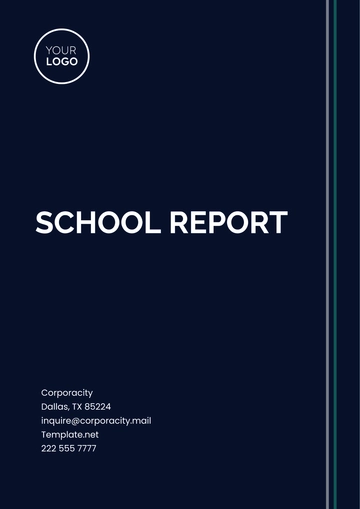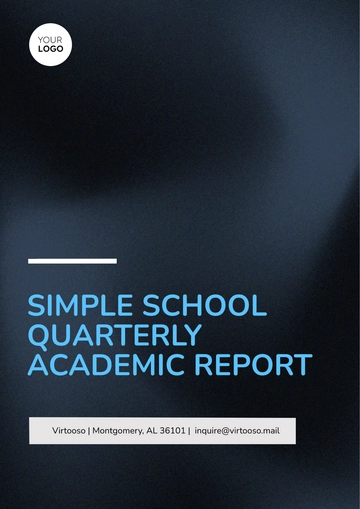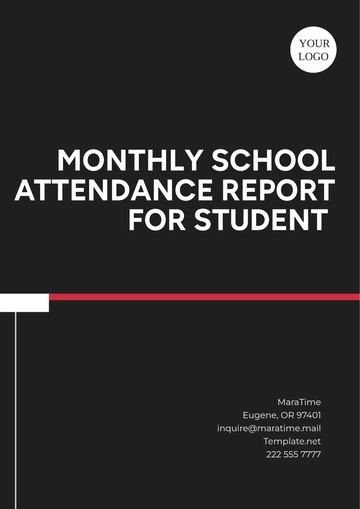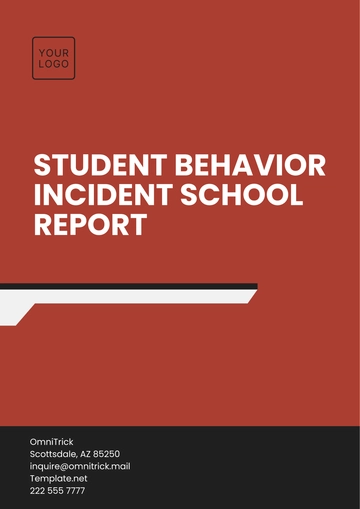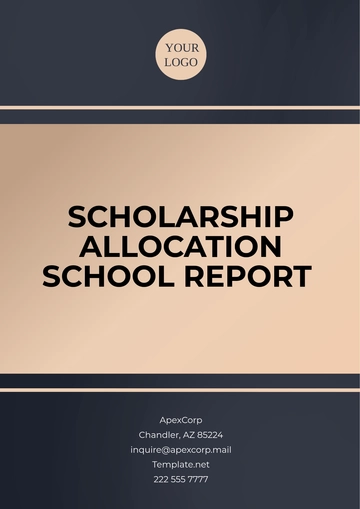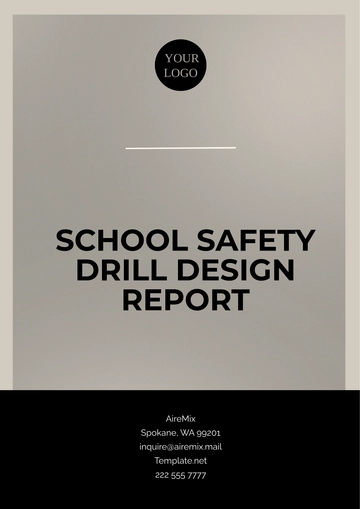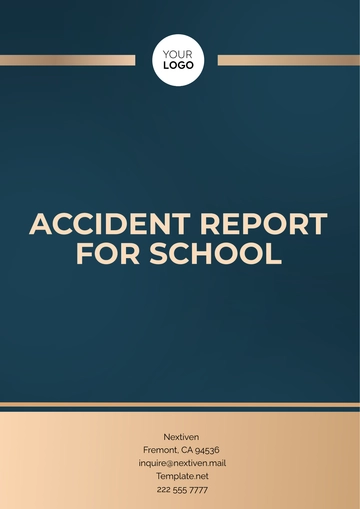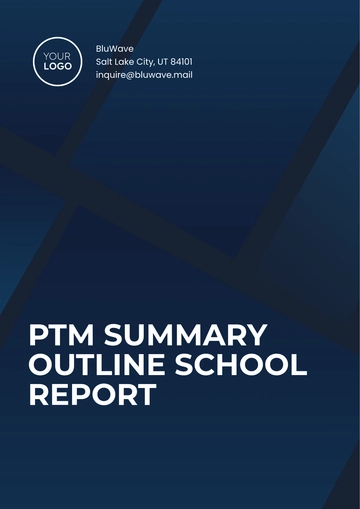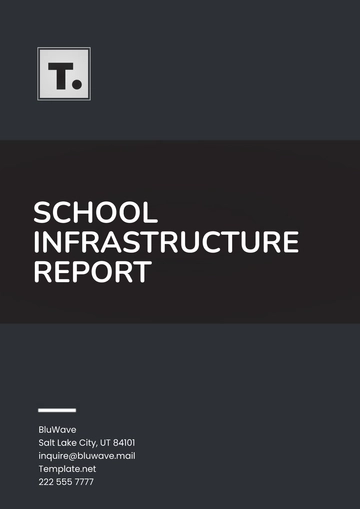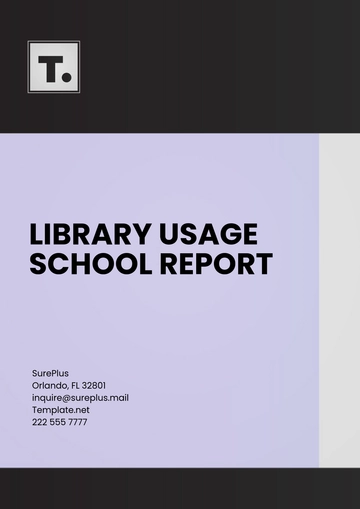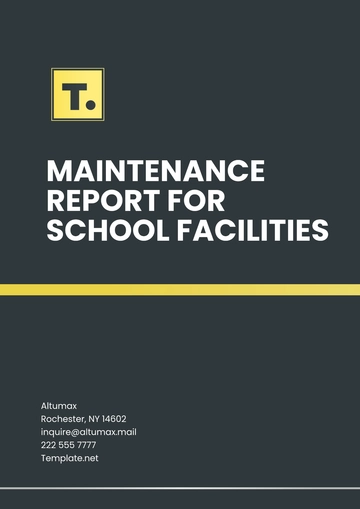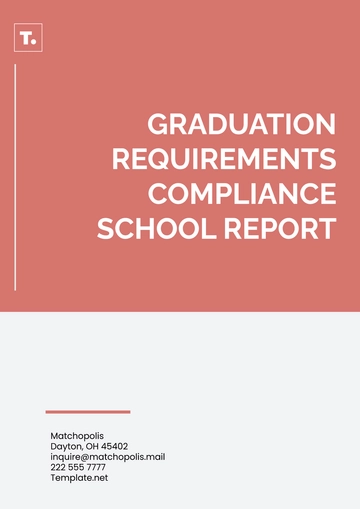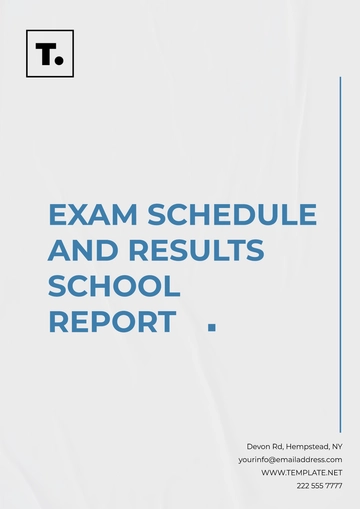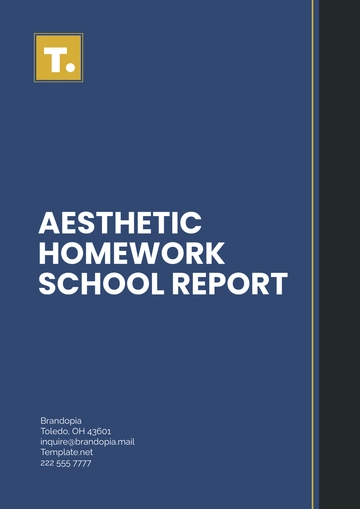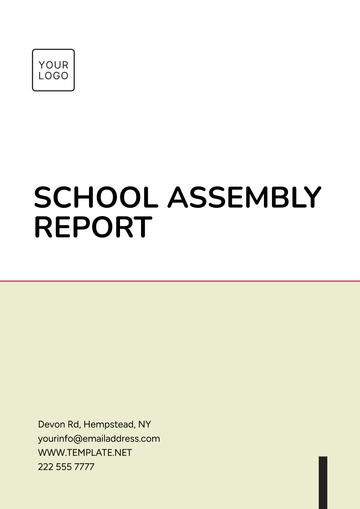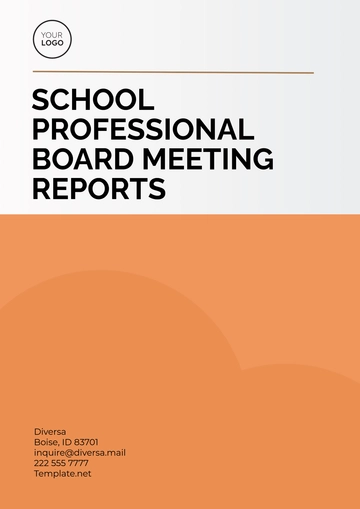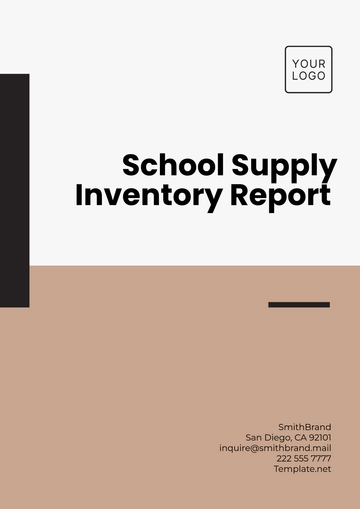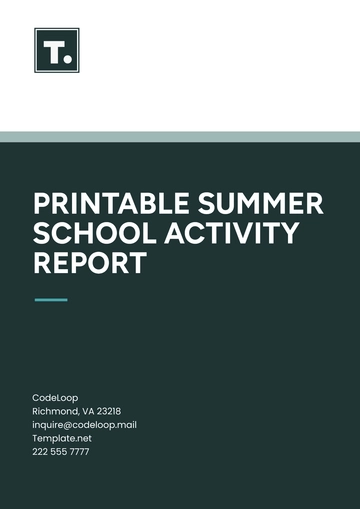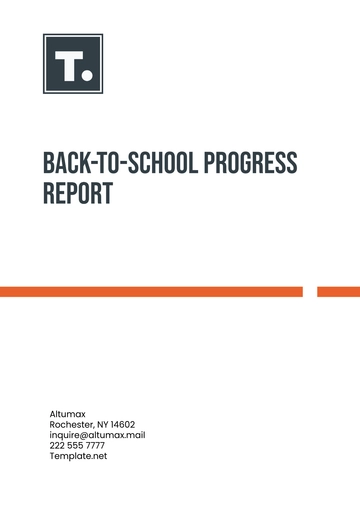Free School Attendance Report
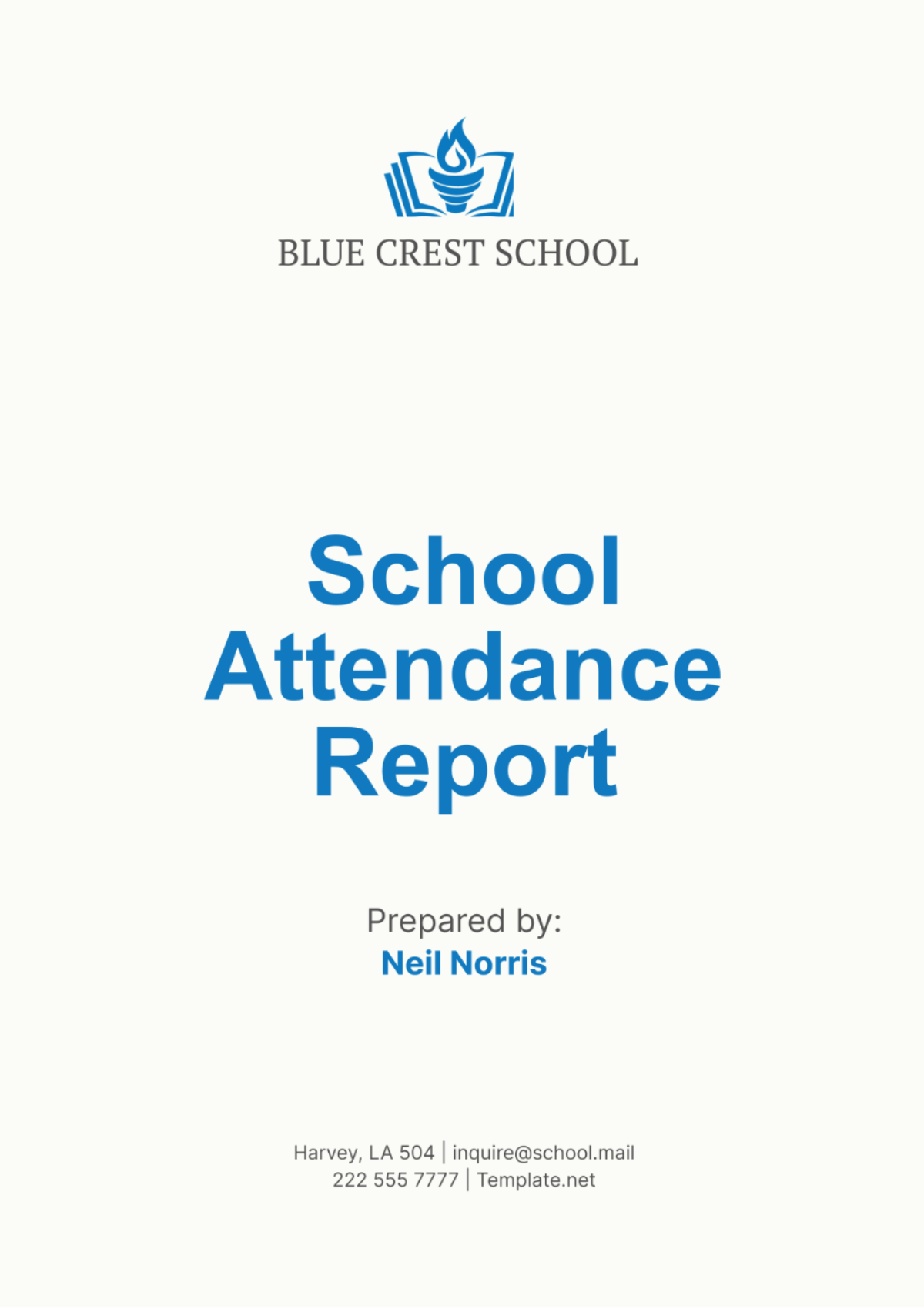
I. Introduction
A. Purpose of the Attendance Report
The School Attendance Report serves as a foundational tool for assessing student engagement and compliance with attendance policies at [Your Company Name]. By analyzing attendance trends, administrators can identify students at risk of academic underachievement and implement targeted interventions to support their success. Moreover, this report aids in fostering a culture of accountability among students and parents regarding regular school attendance, which is crucial for maintaining a conducive learning environment.
B. Importance of Attendance Tracking in Education
Attendance tracking is integral to measuring instructional time and ensuring equitable access to education for all students. It allows [Your Company Name] to meet state and local regulations governing compulsory education and funding allocations based on student attendance. Furthermore, consistent attendance correlates strongly with academic performance and social-emotional development, highlighting its role in promoting student success both academically and holistically.
II. Attendance Data Collection
A. Sources of Attendance Data
Daily Attendance Records
Every morning, during the initial roll call, as well as at various points throughout the school day, teachers meticulously record the attendance of each student using electronic methods. This practice ensures both accuracy and timeliness in tracking student presence. Each instance of a student's absence is then carefully evaluated and categorized as either excused or unexcused. This classification depends on whether the parent or guardian has provided appropriate notification and whether the reason for the absence aligns with the school's established policies.
Excused and Unexcused Absences
Excused absences are those instances when a student is not present at school due to certain acceptable and justifiable reasons. These reasons include the student being ill, having scheduled medical appointments, or experiencing emergencies within their family. For these absences to be officially recognized and excused, there must be valid explanations provided by the student's parents, which serve as documentation for the school administration.
On the other hand, unexcused absences refer to situations where the student misses school without acceptable, legitimate reasons. This can include cases of truancy, where the student deliberately avoids attending school without permission, as well as other unauthorized absences that lack any valid justification. These absences are not supported by appropriate explanations from the parents and are therefore not accepted as excusable by the school.
Tardiness Records
Instances of tardiness are recorded whenever students arrive at their classes or the school premises after the officially designated start time. This recording process plays a crucial role in developing a comprehensive understanding of overall attendance patterns. Consequently, these observations are integral for analyzing student punctuality and attendance behavior.
Date | Total Students | Present | Absent (Excused) | Absent (Unexcused) | Tardies |
|---|---|---|---|---|---|
[Date] | [00] | [00] | [00] | [00] | [00] |
B. Methods of Data Collection
Manual Recording
At first, teachers manually record the attendance data. After this initial step, the recorded information is subsequently entered into the school's electronic management system. This process is performed to guarantee the accuracy and ensure that the data is easily accessible for any administrative purposes that may arise.
Electronic Attendance Systems
At [Your Company Name], we make use of the [Name of Attendance System], a comprehensive and sophisticated system that enables real-time monitoring and detailed reporting of student attendance. This advanced technology ensures that any absences are promptly communicated to parents through immediate notifications. Additionally, it provides critical support for school administrators by facilitating data-driven decision-making processes, thereby enhancing the overall management of student attendance records.
III. Attendance Reporting Period
A. Timeframe Covered by the Report
This detailed report covers the entirety of the academic year, beginning on [Date] and concluding on [Date], which includes a full 180 instructional days. The report thoroughly examines attendance trends over the course of the school year, aiming to uncover patterns and evaluate the effectiveness of various interventions implemented during this period. Each aspect of attendance is meticulously analyzed to ensure a complete understanding of student attendance behavior and the impact of any strategies employed to improve it.
B. Frequency of Reporting
Monthly, attendance reports are meticulously generated to facilitate a comprehensive monitoring of trends and patterns effectively. This systematic and regular reporting schedule plays a crucial role in enabling timely intervention strategies, which are designed to support students facing attendance challenges. Additionally, it ensures that there is consistent adherence to educational mandates, thereby promoting an environment conducive to accountability and continuous improvement in student attendance.
IV. Attendance Metrics
A. Key Metrics Tracked
Total Enrollment
At the beginning of the academic year, [Your Company Name] successfully registered and enrolled a total of six hundred students, encompassing individuals from all different grade levels across the educational spectrum.
Average Daily Attendance (ADA)
During the entire duration of the reporting period, the average daily rate of student attendance was recorded to be 95%. This consistently high percentage serves as an indication that there was a strong and pervasive presence of students in their respective classes throughout this time frame.
Absence Rate
Throughout the academic year, the overall absence rate amounted to five percent of the total school days. This absence rate can be further detailed as follows: excused absences accounted for three percent of the total school days, while unexcused absences contributed an additional two percent.
B. Definitions of Terms Used
Excused Absence
Absences that are validated through notification by a parent or guardian, which may include reasons such as illness, medical appointments, and family emergencies, will be recognized and accepted.
Unexcused Absence
Absences that occur without a valid justification or without notification from a parent or guardian, including behaviors such as skipping class or engaging in truancy, will be subject to disciplinary action in accordance with the established policies of the school.
V. Analysis of Attendance Data
A. Trends and Patterns Identified
An in-depth examination of the attendance data has uncovered a number of significant trends worth noting. For example, there is a noticeable and consistent decrease in attendance rates that occurs after extended weekends or holiday breaks. This pattern suggests that there may be challenges associated with students returning promptly to their established school routines following these prolonged periods of absence. Furthermore, the analysis indicates that certain grade levels or particular classes experience higher rates of tardiness. This observation points to a potential need for targeted interventions aimed at improving punctuality within these specific groups.
B. Comparison with Previous Reporting Periods
When we compare the current attendance data with that from the previous academic year, we can see a slight improvement in the overall attendance rates. Nonetheless, it is important to note that there are still significant differences in attendance among various student groups and demographics. This indicates that there is a need for ongoing initiatives and strategies to ensure more uniform attendance across all grade levels.
C. Impact of Attendance on Student Performance and Engagement
Students who consistently attend their classes and programs tend to showcase superior academic performance, excelling in their studies and grasping the material more effectively. These students also exhibit higher levels of involvement and participation in classroom activities, which could include discussions, group projects, and interactive lessons. Beyond the classroom, they are often more engaged in extracurricular pursuits such as sports teams, clubs, and other school events, which fosters a well-rounded educational experience and personal development. In contrast, students who are frequently absent from school or miss a significant number of classes often show a decline in their academic achievements. They may struggle to keep up with coursework, find it challenging to understand new concepts, and have difficulty catching up on missed lessons.
This academic gap can lead to lower grades and a diminished overall performance. Additionally, these students may face obstacles in building and maintaining peer relationships. Regular absences can hinder their ability to integrate socially within the school community, making it harder for them to establish and sustain friendships and engage in social activities. Consequently, these students might feel isolated or disconnected from their peers, further complicating their school experience.
VI. Attendance Report Format
A. Structure of the Report
The report is designed to give an all-encompassing view of attendance metrics, presenting the information in a format that breaks down into several meticulously organized sections. These sections include, firstly, a summary that highlights the most crucial data points related to attendance. Following this, there are graphical representations which depict trends over a certain period, making it easier to visualize shifts and patterns in attendance.
Finally, the report delves into detailed analyses of attendance records for individual students. These detailed records are restricted and can only be accessed by authorized personnel to maintain the privacy and confidentiality of the students' information.
B. Components Included
Summary of Attendance Data
This particular section provides an in-depth overview of various components related to attendance, including the Average Daily Attendance (ADA) rates, absence rates, and tardiness statistics. By presenting this detailed information, it serves as a concise yet comprehensive reference tool specifically designed for administrators. This tool enables them to quickly and effectively evaluate and understand the overall patterns and trends in student attendance.
Charts and Graphs
Visual representations, which include formats like bar graphs and pie charts, serve to illustrate the trends in monthly attendance. They also provide a means of comparison between various groups of students. These tools aid in the interpretation of the data and support informed decision-making processes.
Student-specific Attendance Details
The confidential sections meticulously document the attendance records for each individual student. This thorough recording process serves a critical purpose, as it allows educational professionals to precisely identify and monitor students who exhibit patterns of chronic absenteeism or consistent issues with punctuality. By having access to these detailed attendance data, schools and educators are better equipped to develop and implement specific interventions and support strategies. These tailored approaches are designed to address and mitigate the underlying problems that lead to frequent absences or lateness, thereby fostering improved attendance and overall student success and well-being.
VII. Attendance Interventions and Strategies
A. Interventions Implemented for Students with Poor Attendance
To address absenteeism effectively, [Your Company Name] implements a multi-tiered approach involving:
Individualized meetings with parents/guardians to discuss attendance concerns and collaborate on solutions.
Development of personalized attendance improvement plans (AIPs) outlining specific goals and strategies to enhance attendance.
Utilization of school counselors or social workers to provide additional support and resources for students facing attendance challenges.
B. Strategies to Improve Overall Attendance Rates
Parent and Community Engagement Initiatives
Regular workshops, newsletters, and informational sessions serve as a valuable means to educate parents about the critical importance of regular school attendance. Additionally, these resources actively engage parents and seek to enlist their partnership in the concerted effort to promote and ensure punctuality and consistent attendance among students. Through these combined efforts, parents gain a deeper understanding of the impact of regular attendance on their children's academic performance and overall development, further encouraging them to support and reinforce these values at home.
Attendance Incentive Programs
Programs designed to acknowledge and commend students, such as those that distribute monthly attendance awards or offer incentives for classrooms that achieve the highest attendance rates, serve to encourage students to view attendance and punctuality not merely as responsibilities, but as essential elements that contribute significantly to their overall academic success.
VIII. Legal and Compliance Considerations
A. Local and State Attendance Regulations
[Your Company Name] diligently adheres to the laws of [State] that govern compulsory education and the reporting of attendance. Our commitment includes the meticulous and precise documentation of attendance records, as well as full compliance with all mandated reporting requirements. This adherence ensures both transparency and accountability in our educational practices, aligning with the highest standards set by state regulations.
B. Compliance with Educational Standards
The attendance report is in harmony with the educational objectives set forth by [Your Company Name], which aim to cultivate a nurturing and supportive learning environment. In this environment, consistent and regular attendance is recognized as a key factor contributing to both academic success and the general well-being of students. By maintaining and upholding these high standards, [Your Company Name] is committed to ensuring that every student has equitable access to educational opportunities.
C. Documentation and Record-Keeping Practices
All attendance data and all interventions are documented meticulously, taking great care to adhere to each and every policy and guideline established by [Your Company Name]. This thorough documentation process guarantees the confidentiality and the accuracy of the attendance records. As a result, it supports making informed decisions and taking responsive actions that are essential for improving attendance rates and enhancing student outcomes.
IX. Conclusion
A. Summary of Findings
The comprehensive analysis presented in this report underscores the critical role of attendance in shaping student success and school performance. By identifying attendance trends, implementing targeted interventions, and fostering a culture of accountability, [Your Company Name] aims to enhance overall attendance rates and promote academic excellence among its student body.
B. Recommendations for Future Actions
Moving forward, [Your Company Name] recommends continued monitoring of attendance patterns, enhancement of intervention strategies, and collaboration with stakeholders to sustain and improve attendance rates. By strengthening partnerships with parents, leveraging community resources, and maintaining compliance with educational regulations, [Your Company Name] endeavors to foster a supportive learning environment conducive to student achievement.
- 100% Customizable, free editor
- Access 1 Million+ Templates, photo’s & graphics
- Download or share as a template
- Click and replace photos, graphics, text, backgrounds
- Resize, crop, AI write & more
- Access advanced editor
Create a comprehensive School Attendance Report effortlessly with Template.net's editable and customizable template. Tailor attendance data with precision using the intuitive AI Editor Tool. Perfect for school administrators, it streamlines tracking of daily attendance, analysis of trends, and compliance with educational standards. Simplify reporting and enhance student engagement with this essential tool for educational excellence.
You may also like
- Sales Report
- Daily Report
- Project Report
- Business Report
- Weekly Report
- Incident Report
- Annual Report
- Report Layout
- Report Design
- Progress Report
- Marketing Report
- Company Report
- Monthly Report
- Audit Report
- Status Report
- School Report
- Reports Hr
- Management Report
- Project Status Report
- Handover Report
- Health And Safety Report
- Restaurant Report
- Construction Report
- Research Report
- Evaluation Report
- Investigation Report
- Employee Report
- Advertising Report
- Weekly Status Report
- Project Management Report
- Finance Report
- Service Report
- Technical Report
- Meeting Report
- Quarterly Report
- Inspection Report
- Medical Report
- Test Report
- Summary Report
- Inventory Report
- Valuation Report
- Operations Report
- Payroll Report
- Training Report
- Job Report
- Case Report
- Performance Report
- Board Report
- Internal Audit Report
- Student Report
- Monthly Management Report
- Small Business Report
- Accident Report
- Call Center Report
- Activity Report
- IT and Software Report
- Internship Report
- Visit Report
- Product Report
- Book Report
- Property Report
- Recruitment Report
- University Report
- Event Report
- SEO Report
- Conference Report
- Narrative Report
- Nursing Home Report
- Preschool Report
- Call Report
- Customer Report
- Employee Incident Report
- Accomplishment Report
- Social Media Report
- Work From Home Report
- Security Report
- Damage Report
- Quality Report
- Internal Report
- Nurse Report
- Real Estate Report
- Hotel Report
- Equipment Report
- Credit Report
- Field Report
- Non Profit Report
- Maintenance Report
- News Report
- Survey Report
- Executive Report
- Law Firm Report
- Advertising Agency Report
- Interior Design Report
- Travel Agency Report
- Stock Report
- Salon Report
- Bug Report
- Workplace Report
- Action Report
- Investor Report
- Cleaning Services Report
- Consulting Report
- Freelancer Report
- Site Visit Report
- Trip Report
- Classroom Observation Report
- Vehicle Report
- Final Report
- Software Report
